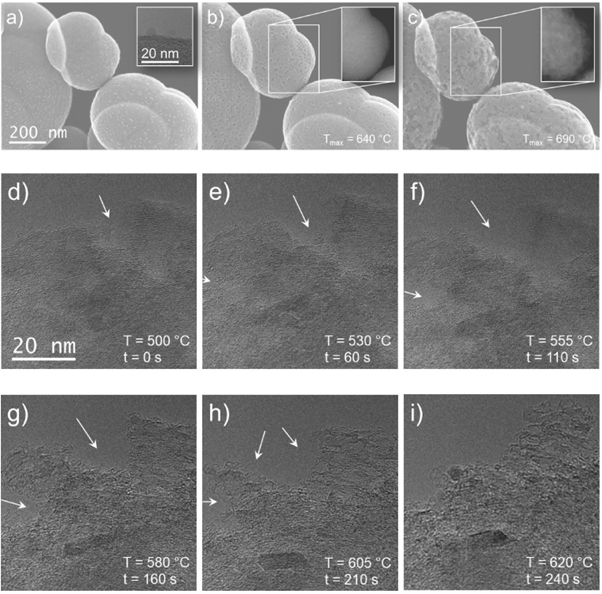Oxidation of carbon nanomaterials using a nanoparticulate iron oxide catalyst: Direct observations in an electron microscope

Oxidation of carbon black N990. Top row frames (a–c) were recorded in STEM mode using SE detector. Frame (a) was captured before oxidation started. Frames (b) and (c) were recorded after pausing the oxidation at Tmax = 640 °C and Tmax = 690 °C, respectively. Inset images show a TEM image of two catalyst particles on the surface of N990 (a), and indicated areas imaged by the HAADF detector in STEM mode (b–c). The two bottom rows (d–i) show close-up ETEM video frames from the surface of a N990 nanoparticle during continuous oxidation and temperature ramping between 500 and 620 °C. The arrows indicate areas under oxidative attack.
Understanding of carbon nanomaterials oxidation is useful in many different applications, e.g., for soot emission abatement, or in defect engineering aiming to improve material properties. In a collaboration between Luleå University of Technology, RISE and Lund University, the oxidative behavior of three substantially different qualities of carbon black, multiwall carbon-nanotubes, and few-layer graphene, was studied using a combination of macroscale quantification (using thermogravimetric analysis) and nanoscale imaging of their structural evolution (using environmental transmission electron microscopy, ETEM). The materials were investigated both with and without the addition of a nanoparticulate iron oxide catalyst. Catalyst addition clearly lowered the conversion temperature during oxidation. The ETEM revealed that the catalyst nanoparticles induced primary surface damages in the carbon nanostructure at relatively low temperatures. From there, oxidation could proceed more rapidly at recently exposed edge sites due to their higher propensity for oxidation. Thus, the enhanced oxidation was not solely linked to the interface between catalyst and carbon.
The work was recently published in Carbon, Volume 234, 5 March 2025, 119896 (https://doi.org/10.1016/j.carbon.2024.119896) by Fredrik Weiland, Mattias Mases and Henrik Wiinikka at LTU/RISE and Daniel Madsen, David Wahlqvist and Martin Ek at LU.
